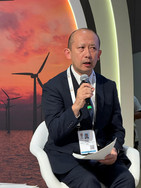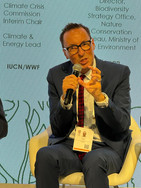GINGR at the IUCN World Conservation Congress in Abu Dhabi
- GINGR – Global Initiative for Nature, Grids and Renewables

- Sep 29
- 3 min read
Updated: Nov 13

From 9 – 15 October, at the IUCN World Conservation Congress in Abu Dhabi, GINGR convened a ministerial panel and a closed-door finance roundtable. Both focused on aligning rapid renewable expansion with protecting 30 per cent of nature by 2030 and supporting community well-being. The sessions were co-hosted with IUCN and the Renewables Grid Initiative.
Leaders highlighted practical governance, planning and finance tools, with clear biodiversity safeguards and social equity built in. They called for stronger international collaboration, transparent metrics, and investment flows that make the transition truly Nature- and People-Positive. The outcomes advance GINGR’s global framework and invite partners to stay engaged.

High-Level Panel on Renewables, Grids, and Nature Protection
Balancing renewable energy expansion with global biodiversity goals
Our high-level panel gathered ministers and senior policymakers to explore how governments can deliver on the COP commitment to triple renewable energy capacity while protecting 30% of nature by 2030.
The dialogue underscored the urgent need to embed biodiversity safeguards and social equity into national energy strategies. Panellists called for stronger international cooperation, clear sustainability metrics, and financial frameworks that make the energy transition truly Nature- and People-Positive.
The session was moderated by Tinne Van der Straeten, Former Minister of Energy of Belgium, who guided the discussion towards practical solutions and global collaboration. In her closing remarks, she emphasised that “delivering the energy transition requires governments to work across borders and sectors—placing people at the heart of every decision.” The panel emphasised that renewable energy deployment must restore ecosystems, empower local communities, and drive lasting climate resilience.

Speakers
Tinne Van der Straeten, Former Minister of Energy, Belgium (Moderator)
Gauri Singh, Deputy Director General, IRENA – International Renewable Energy Agency
Ralph Regenvanu, Minister for Climate Change Adaptation, Energy, Environment, Meteorology, Geo-hazards and Disaster Management, Vanuatu
Juan Carlos Navarro, Minister of Environment, Panama
Manuel Pulgar-Vidal, IUCN Climate Action Commission Chair, World Wildlife Fund Climate & Energy Lead
Wataru Suzuki, Director, Biodiversity Strategy Office, Nature Conservation Bureau, Ministry of the Environment of Japan
Oliver Conz, Director-General, Federal Ministry for the Environment, Climate Action, Nature Conservation and Nuclear Safety of Germany
Building on the ministers’ insights, the panel asked GINGR to turn policy direction into investable pathways, highlighting needs such as biodiversity positive siting and design, grid modernisation in sensitive areas, early community benefit agreements and transparent monitoring.
These signals set up the Finance Roundtable to test how lenders can price nature risk, apply the GINGR Framework in due diligence and reporting, and channel capital to pipelines that deliver measurable benefits for people and ecosystems. With the policy foundations clarified, the discussion moved naturally to mobilising finance at scale to turn commitments into projects on the ground.
Finance Roundtable
Investing in Nature-Positive Renewable Energy and Grid Infrastructure
Our finance roundtable convened leading financial institutions, multilateral development banks, and conservation experts to discuss how capital can accelerate the just energy transition. The exchange was open, constructive, and forward-looking, reflecting a shared commitment to align investment flows with biodiversity protection.

This dialogue marked an important first step towards continued exchange and cooperation between the finance sector and GINGR. Participants expressed a clear interest in working together to build a financial architecture that supports Nature- and People-Positive renewable energy and grid development worldwide.
Follow the Nature- and People-Positive journey
Together, these discussions mark a milestone for GINGR and our mission to co-design a global Nature- and People-Positive Framework. This system will help governments, developers, and financiers measure and enhance the contributions of renewable energy and grid infrastructure to biodiversity recovery and social resilience.
The Global Initiative for Nature, Grids and Renewables works to ensure that the clean energy transition delivers benefits for climate, nature and people. By developing a globally aligned framework for monitoring and reporting, GINGR helps governments, financial institutions and developers integrate biodiversity protection and community well-being into the rapid scale-up of wind, solar and electricity grids. GINGR is co-led by IUCN and the Renewables Grid Initiative.
Subscribe to our newsletter for updates on our Technical Working Groups, examples of good practice and opportunities to engage with this work.
















